Why Streamers? A Complete Angler’s Guide to Streamer Fishing for Steelhead
By: Karl Weixlmann
October 27, 2025
Why streamers? It’s really a simple question to answer. It’s because I like absolute violence unleashed at the end of my fly line. The take when swinging a big articulated fly is just that, and few other freshwater fly fishing pursuits can come close to replicating it. That smashing hit can literally rip the rod right out of your hand, the electric pulse thumping through the rod as a steelhead thrashes to the surface, shaking its head back and forth, diving back down and then going airborne. A muskie might come close, but just yesterday I watched a 50 inch muskie on YouTube, using a one, one thousand one count, netted in just 8 seconds. That will never happen with a 30 inch steelhead, even if hooked using heavy fly fishing tackle. Large and smallmouth bass hooked on topwater may be thrilling, but you're never going to chase a bass down the river for 50 yards. Pike, yes the take can be violent and big ones can put your heart in your throat, but stamina is not one of their strong attributes. I think many of us evolve as steelheaders, and after you’ve done it for a while and have caught a bunch of them, it sometimes becomes more important, or maybe just more exciting, how you catch them, than how many you caught. Creating my own articulated streamer patterns and swinging them with a two hander on big water has become my favorite way to catch them, thanks to the influence of friends like Jack Hanrahan and Steve Brugger. Over the last decade or so, many of my largest steelhead of the entire season have been caught while swinging big stuff.
Why streamers? It’s really a simple question to answer. It’s because I like absolute violence unleashed at the end of my fly line. The take when swinging a big articulated fly is just that, and few other freshwater fly fishing pursuits can come close to replicating it. That smashing hit can literally rip the rod right out of your hand, the electric pulse thumping through the rod as a steelhead thrashes to the surface, shaking its head back and forth, diving back down and then going airborne.
A muskie might come close, but just yesterday I watched a 50 inch muskie on YouTube, using a one, one thousand one count, netted in just 8 seconds. That will never happen with a 30 inch steelhead, even if hooked using heavy fly fishing tackle. Large and smallmouth bass hooked on topwater may be thrilling, but you're never going to chase a bass down the river for 50 yards. Pike, yes the take can be violent and big ones can put your heart in your throat, but stamina is not one of their strong attributes.
I think many of us evolve as steelheaders, and after you’ve done it for a while and have caught a bunch of them, it sometimes becomes more important, or maybe just more exciting, how you catch them, than how many you caught. Creating my own articulated streamer patterns and swinging them with a two hander on big water has become my favorite way to catch them, thanks to the influence of friends like Jack Hanrahan and Steve Brugger. Over the last decade or so, many of my largest steelhead of the entire season have been caught while swinging big stuff.
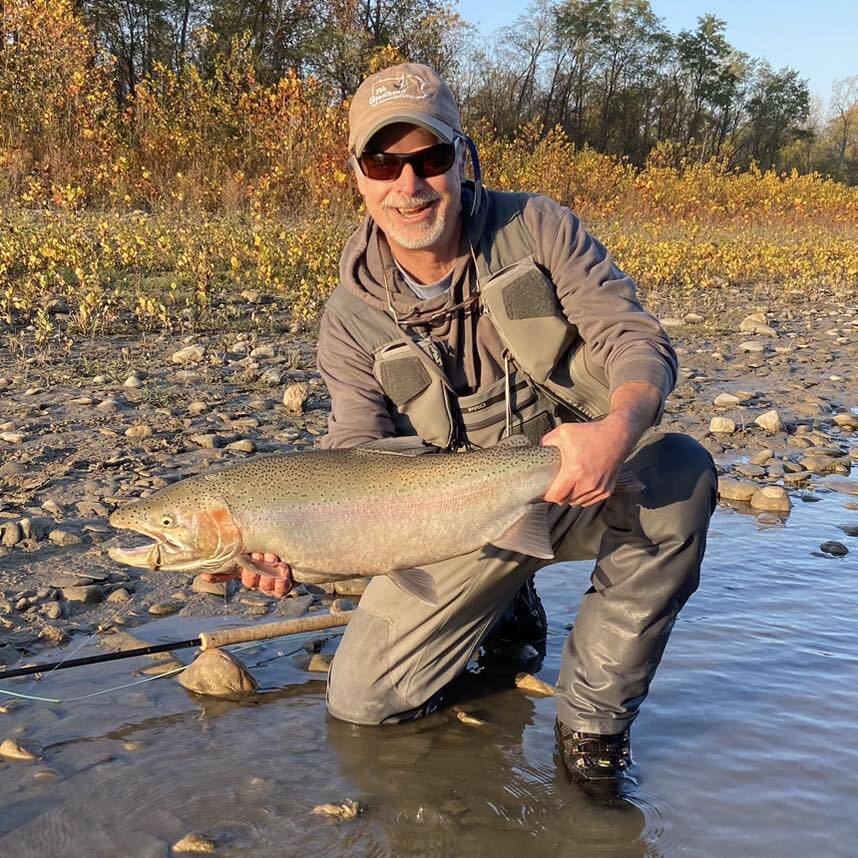
Table of Contents
What Do You Need to Streamer Fish? Fly Rod, Reel, and Line Setup
In my book Fly Fishing Guide to Steelhead Alley, I describe alternatives to the swing game you can use with your current steelhead fly fishing tackle. With the availability of tungsten sink tip leaders in various sink rates and lengths that loop to the end of a fly line, whatever fly rod and floating line you currently have is easily turned into a good streamer fishing tool.
Modern fly lines are available that have floating sections with integrated sink tips in various lengths. Steelhead Alley fly fishers should choose those with sink tip lengths from 6 to 10 feet. During low water conditions you may only need a floating line and a weighted streamer to get down to the fish.
Streamer Fishing Presentations
Only one presentation is normally used with a two hand fly rod, the art of spey casting specialty fly lines with multiple interchangeable tips and the subsurface swinging of a fly. Yet, streamer fishing is not just about swinging, there are so many different, successful ways in which to fish them.
The Swing
It’s a down and across stream cast at an approximately 45 degree angle with an upstream mend or two to sink the fly before current pushes a belly or curvature in the line as it comes down below you. What you want to accomplish is a broadside view of the fly in front of a steelhead that will trigger a take. In heavier, faster water you may need to cast directly across current in order to get the fly down. Swing speed can be controlled by more upstream mends to slow it down, or downstream mends to speed it up. At the bottom of the swing when the fly line straightens out below you, let it dangle and give the rod a pull or two before stripping it back in.
It’s relatively easy to classify water types that beckon a swinging presentation. Look for water that is moving at walking speed, maybe a little faster, that has consistent current and depth across a run, pool bucket, or tailout. I like to divide tributary sections into water types that are best suited for a particular technique. Swing water and indicator nymphing water. You could even include bottom bouncing water, streamer stripping water (slow and deep), and as of late, Euro Nymph tight line water - what we all used to call high stick nymphing water.
For more information on this technique, check out the article “Low Water Fly Fishing Techniques for Steelhead: How To Catch Steelhead in Low and Clear Water”
Many of our tributaries feature corrugated shale substrate bottoms that form U shaped troughs running parallel to the bank making it tough to get a swing in there without hanging up. It’s much easier to make a long drift with an indicator rig in spots like this. When scouting, the idea is to eliminate these areas from consideration and concentrate your efforts on the best swing water you can find throughout a day's fishing.
Leader Rigging for a Swung Fly Setup
Swing rigging off of a sink tip is simple. With heavy big flies in stained water on our larger tributaries I’ll often go 18” of 30 pound Maxima Green to the sink tip, then 18” of 20 pound Maxima Green to 18” of 15 pound Maxima Green. In clearer water with lighter flies I’ll go a little longer using 20lb. to 15lb. to 12lb. Anything lighter and you'll risk the chance of getting snapped off on the hit on big water. Use a loop knot to the fly to give it more movement even when using articulated patterns.
Words of Advice - Let Them Eat It
The most common mistake that I make, (and I’m sure I’m not the only one), while traditional swinging with a two hander is to try to set the hook by lifting the rod as soon as I feel a grab. I’d be embarrassed to think of how many times I’ve done this over the years. It’s akin to trout setting on a pike or muskie hit.
I think this is a muscle memory response from even more years of nymphing with or without an indicator, and I know of some good streamer anglers that strip set on the grab. Sometimes you'll feel a thump and set, though you should continue the swing because they’ll often come right back and smash it. Thank goodness there is a higher percentage of steelhead that absolutely trash the fly on the swing in warmer water temperatures and hook themselves.
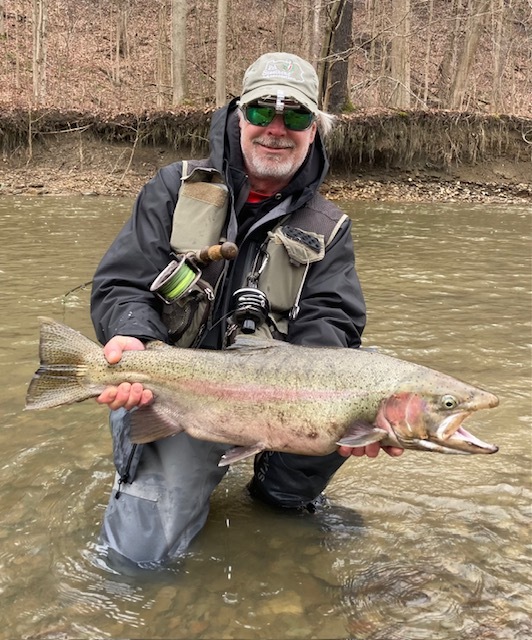
Streamers Upstream
Brett Aurand is one of the best streamer anglers I’ve ever taken out and one year he showed me a unique way of fishing a streamer upstream while fishing some larger pools in Ohio. “It’s a different look from an anglers perspective but the fish probably see it often in real life. You cast a relatively heavy streamer upstream on a floating line from where you want to fish it or where you think a fish’s position to be, using the tip of the rod to throw slack into the current downstream from the fly.”
“The current grabs the belly of the floating line as the fly sinks, bringing it straight downstream. While taking up slack, watch the belly of the fly line for any deviation or stall in the drift which could be a taking fish. Set on any odd movement of the line as you would when nymphing. Steelhead, being an apex predator, hit the fly, or any tumbling baitfish, in the head.” I can attest to its effectiveness, and it's a great way to fish a pool back upstream with a streamer after fishing it down.
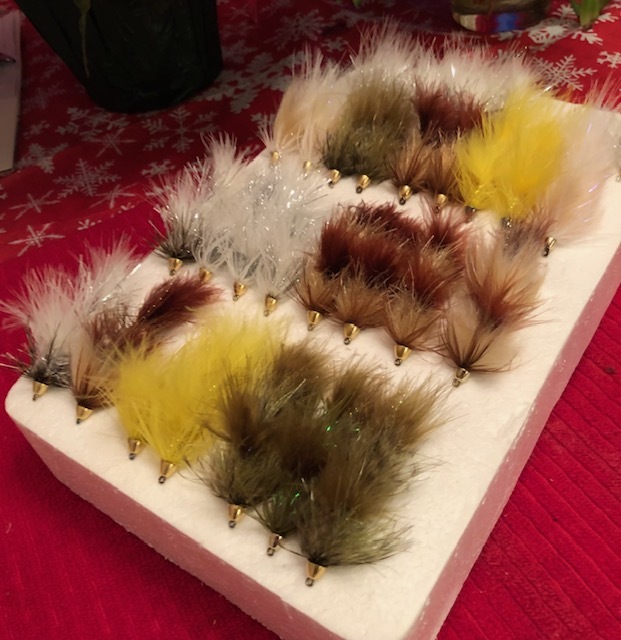
Dirty Water Streamers
The seemingly thousands of steelhead fisherman that flock to Steelhead Alley like to see the fish, it’s why they come here. You see them walking up and down a tributary, peering into the water, wading out farther than they should instead of just fishing it like you know they are there. But I like dirty water, and I like big streamers from 4 to 6 inches long that can displace water with articulation movement, and are easier for the fish to see in these conditions. Conditions that could almost be considered unfishable with only 6 inches or a little more of visibility.
My two favorite streamer colors for dirty water are all yellow and all black with maybe a highlight color added. Tied with a segmented body consisting of two hooks looped together, this articulation gives the fly superior lifelike movement on the swing or strip. Patterns like Circus
Peanuts, Intruders, and Sex Dungeons from 4 to 6 inches long have larger profiles, making them easier for the fish to see.
In dirty water I’m going to mostly blind swing tailouts, working my way down into the two current seams that form a V just above the next riffle. As the fly swings into the middle of this area, I’ll give it a strip which sometimes results in exploding strikes. Another spot is the inside or bankside edge of any seam. These areas are generally shallower and clearer than the deeper, muddier body of a pool where heavy current pushes fish to the edges, giving the fish a better chance to see the fly.
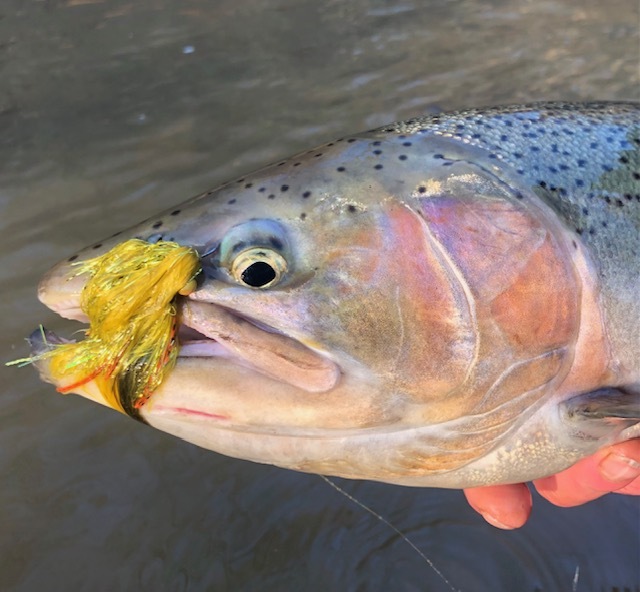
Cold Water
It’s been commonly written that it’s nearly impossible to catch steelhead on streamers or the swing in water temps below 40 degrees. How about below 39, 38,or 37. How about when large chunks of ice are floating down a tributary. I’ve seen it done too many times to discount it. Sure you can hook more steelhead nymphing, tight lining, or whatever. We do it because we want to and because newly entered steelhead in a tributary can still retain a predatory streak, even in cold water.
You have to do it in the opposite places that you would normally try in the fall or spring, these are winter condition fish now that hold in the deepest, slowest water available. Fortunately, some of this water is located on the inside or outside of the current seems where a swing is still possible. With little current and low metabolism fish, I like to get as directly above them as much as possible, standing on cross current ledges to create a slow, soft swing that will keep it in front of them and in their face for as long as possible.
Often the take will feel like you may have snagged bottom and then the rod thumps slowly with a head shake, and if you're not bumping or snagging bottom occasionally, you're not putting the fly where it needs to be. Losing a big articulated fly to the bottom hurts a lot, especially from the time lost to create them. You might have a chance to save it if you can roll cast the floating portion of your line downstream from the hangup so that the current can pull it out. I’ve waded out to the top of my chest to save some of mine which leaves the thought that maybe I should be using something simpler to tie. Tube fly streamers immediately come to mind and might be just as effective in clearer water conditions.
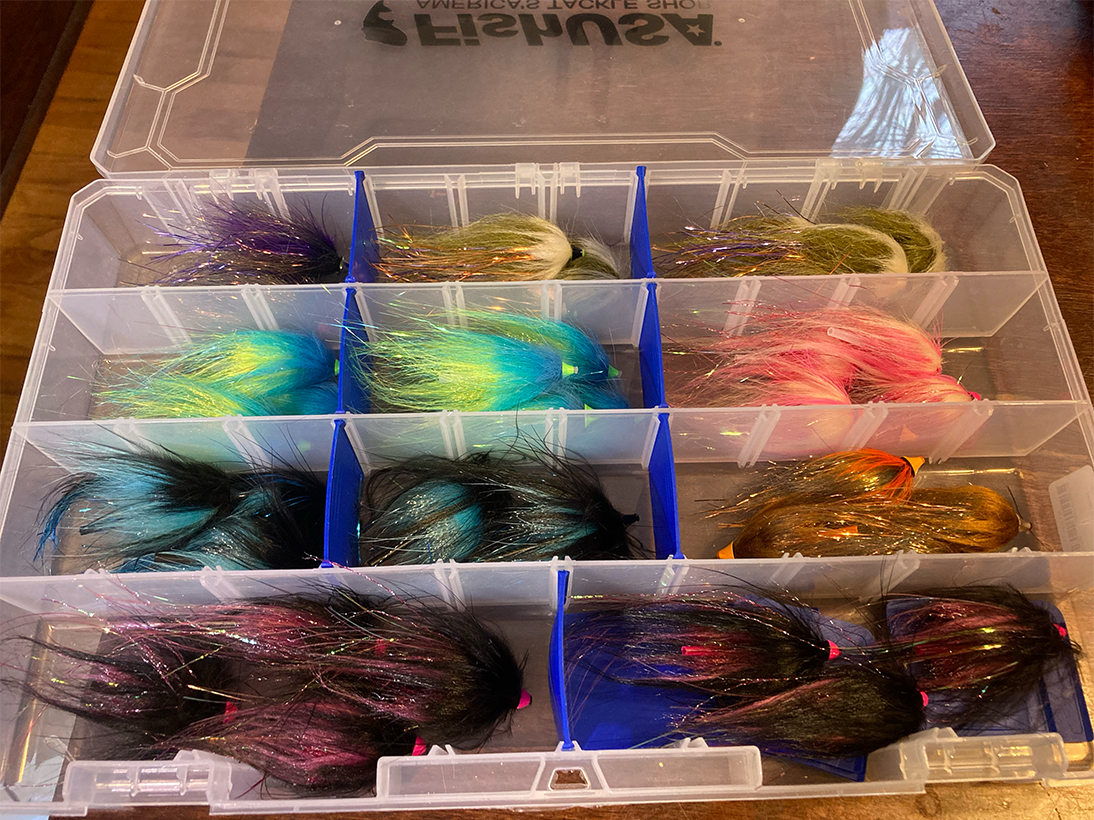
Streamers Under Floats
It’s not heresy. If you're not occasionally fishing a streamer under a float, (strike indicator, bobber, whatever you want to call it), you're probably not catching as many steelhead as you could be. I even use them off of Lake Erie beaches to hook up on surfzone steelhead. An even better place to do it is in the “bucket” of a pool, where the fast water enters the deeper front and middle of a pool. Not many steelhead will pass up a dead minnow drifting past them in this water type. The slower, shallower tailout is better for swinging or stripping the streamer.
I like using teardrop style floats with staggered shot between the fly and float, because the float points to where your fly is. When the float is in a vertical position the fly is directly under the float and correctly on a dead drift. If the bottom end of the float is pointing downstream, you need to make a downstream mend to make the float go vertical. If it’s pointed upstream, make an upstream mend to get the streamer under the float as quick and as deep as needed. A round indicator/float gives no reference to the position of the fly in the water column and gives more resistance to a taking fish. A couple of my favorite flies for doing this include a White Zonker or a Creek Minnow Precious, under what would be considered normal water conditions.
Stripping Streamers
Stripping in a streamer can be a lot of fun, especially when you can watch a steelhead chase it and eat it in front of you. It’s an effective technique on early run fish fresh from the lake that have not seen a lot of pressure and you can usually get by with a floating line and a standard 9’ tapered leader in these lower water conditions. Streamers tied with dumbbell eyes give them an enticing action with a short, sharp strip and fall of the fly, and ones tied Clouser Minnow style with a lot of flash material really turn them on. Stripping on the swing with sink tips, giving the line a few sharp pulls as a streamer arcs below you can also sometimes elicit strikes.
Popular Streamer Patterns for Steelhead
There are times when streamer patterns that imitate various baitfish species, and ones that look nothing like anything in nature but give the illusion of something alive, work better than the other. When tying, use materials that provide a lot of movement in the water like rabbit strips, marabou, and soft hackles. For body construction along the hook shank I like to use Polar Fiber Streamer Brushes that come in myriad colors and shades. A lot of modern patterns incorporate the use of rubber “legs” that add to the movement of the other materials.
Some of my favorite streamer patterns include Ray’s Sculpin tied by Adam Slavinski, Simple Intruder tied by Mike Veatch, and a Black and Blue Swing Bugger tied by Paul Krott. All these and many more, along with tying recipes can be found in Fly Fishing Guide to Steelhead Alley.
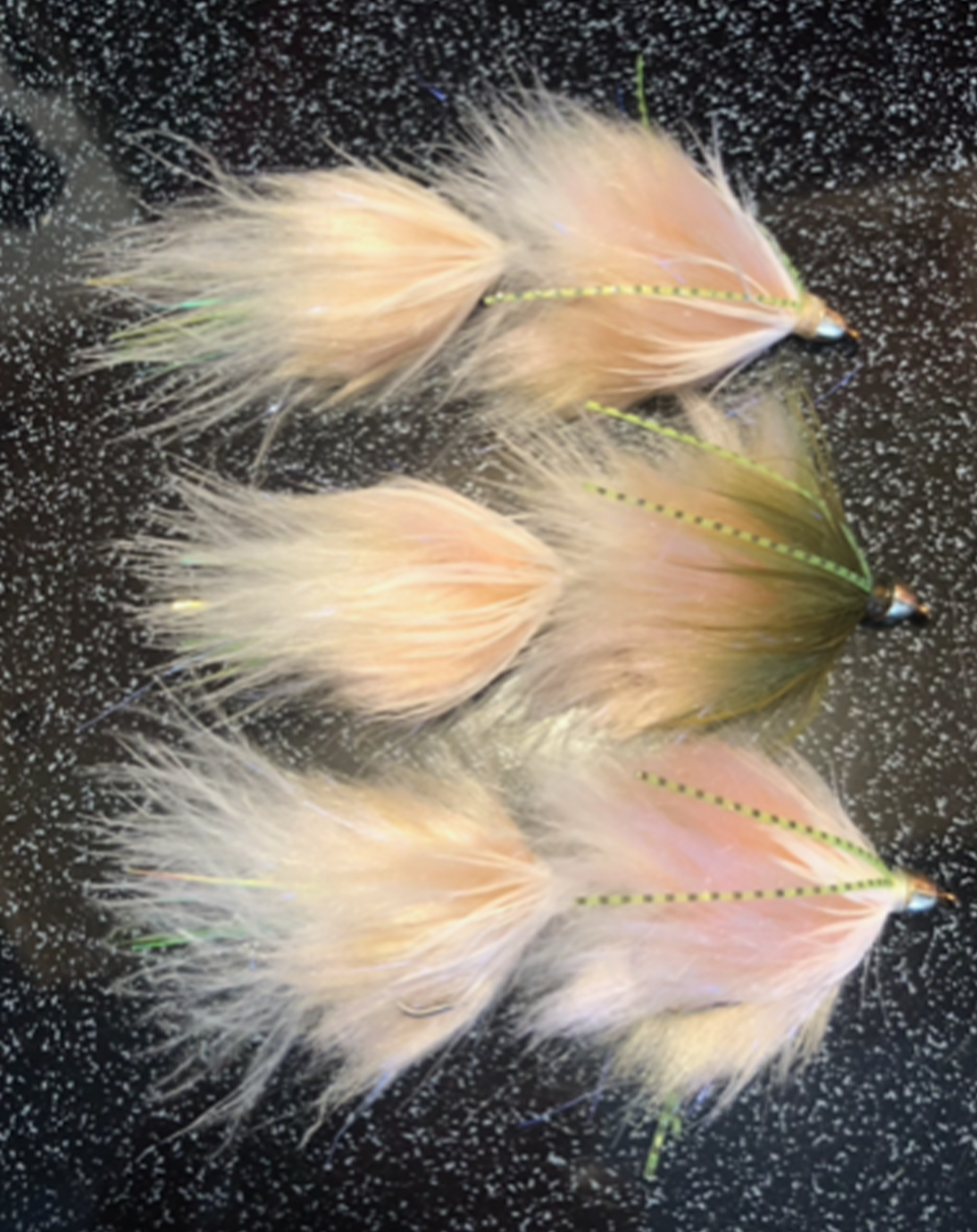
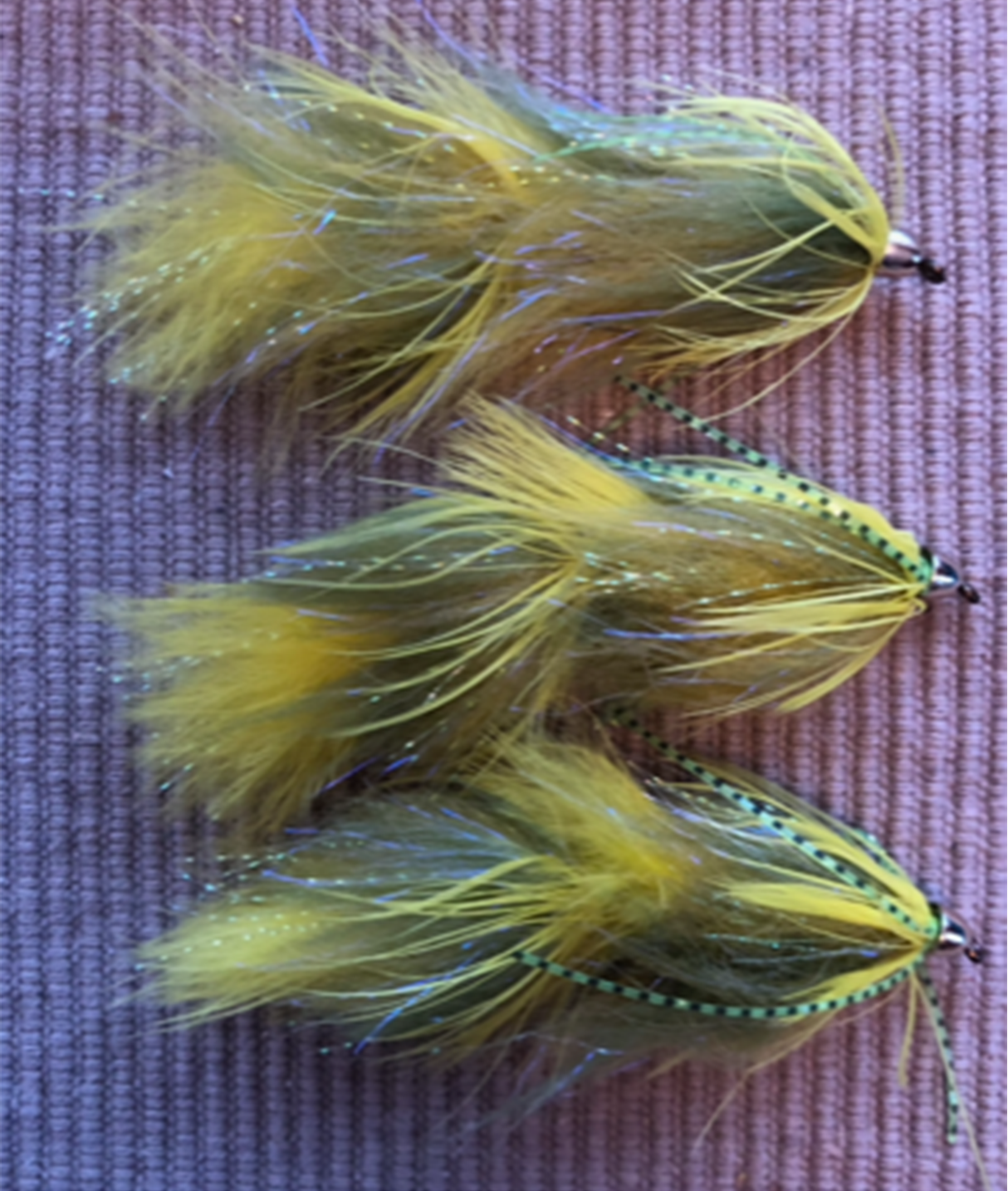
Closing
Fly fishing for steelhead with streamer patterns is probably the most enjoyable way to catch them. For one, in most instances, you're actually fly casting (enjoyable on its own), not flipping or chucking and ducking, or staring down a bobber floating down a stream. You're not looking for a dunk or a hesitation in the drift. You're going to feel a grab which at times can be fast and furious, and it’s that kind of connection to a steelhead that I want to experience over and over. And so should you.
Shop Fly Fishing Gear

